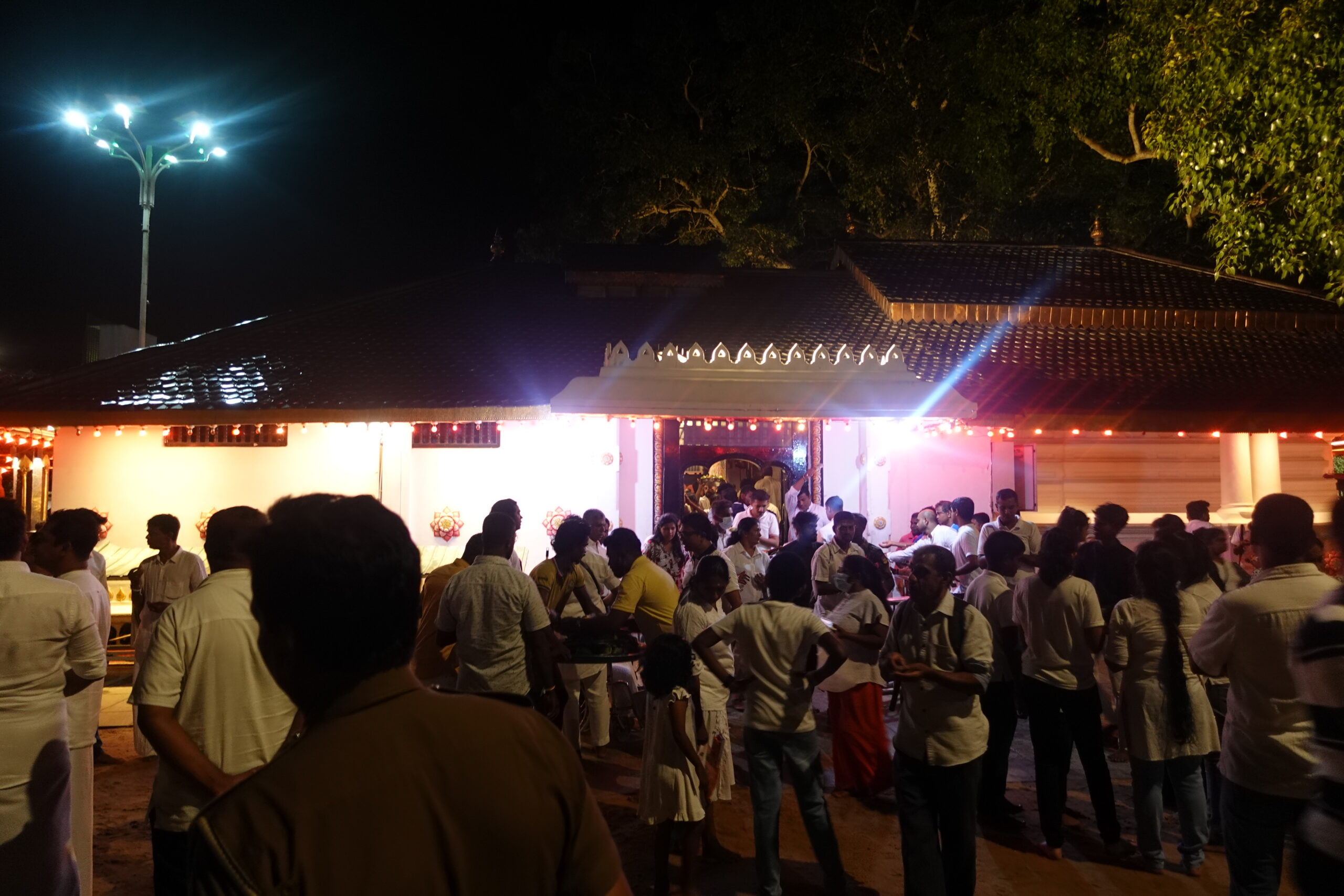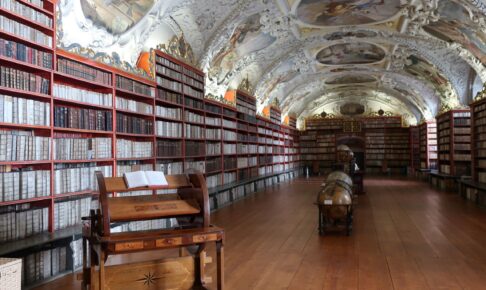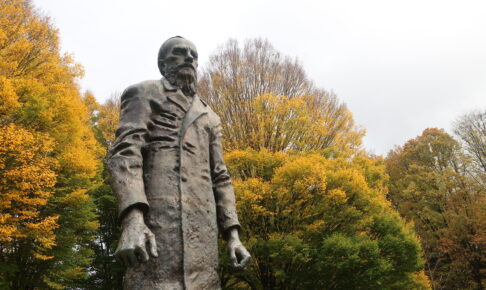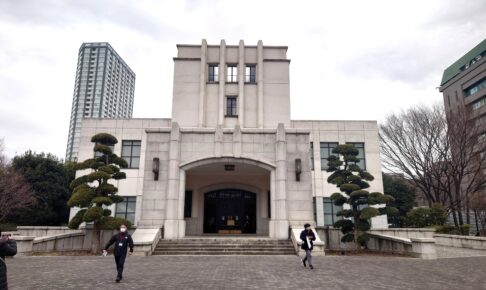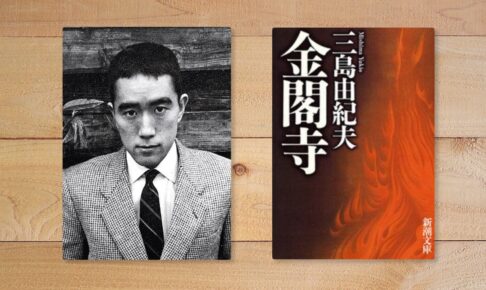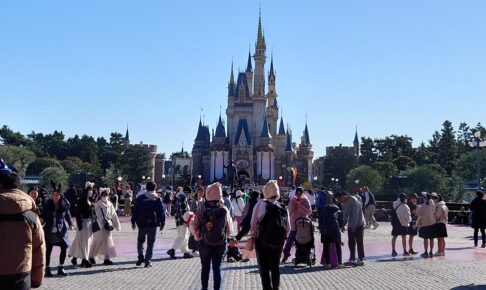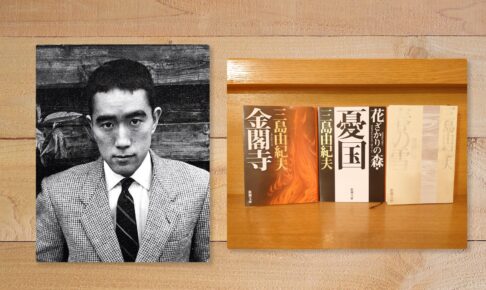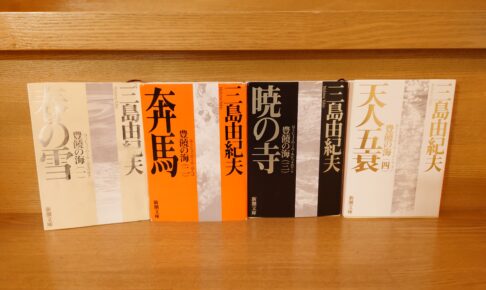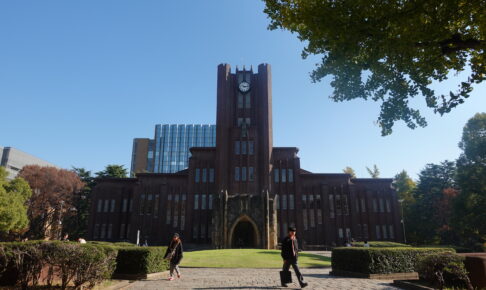Travels to Buddhist sites in India and Sri Lanka (51)
Experience the Buddhistization of the Hindu holy city of Kataragama and nighttime pujas - Amazing difference from India.
Previous Article(50) To Katharagama, the most popular pilgrimage site in Sri Lanka, and the belief in Lord Katharagama, who can make anything come true.I spoke about Katharagama, the most popular pilgrimage site in Sri Lanka, in
God Kataragama grants all kinds of personal wishes. In Colombo, where capitalistic business was rapidly developing, it was the god Kataragama to whom one could put one's wish to "win at all costs" and "absolutely succeed financially".
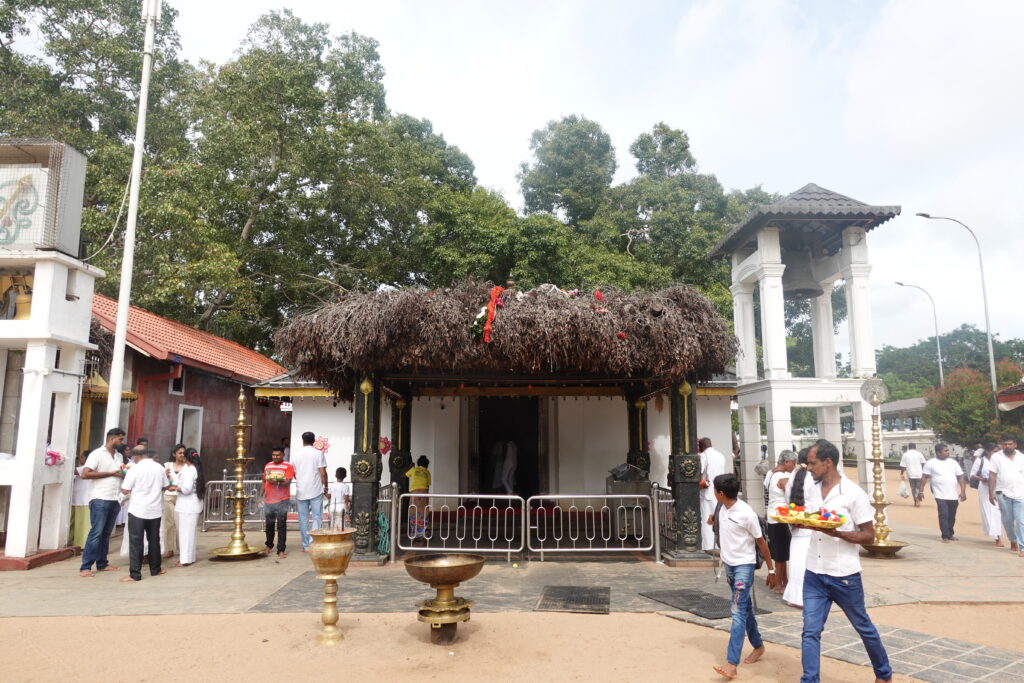
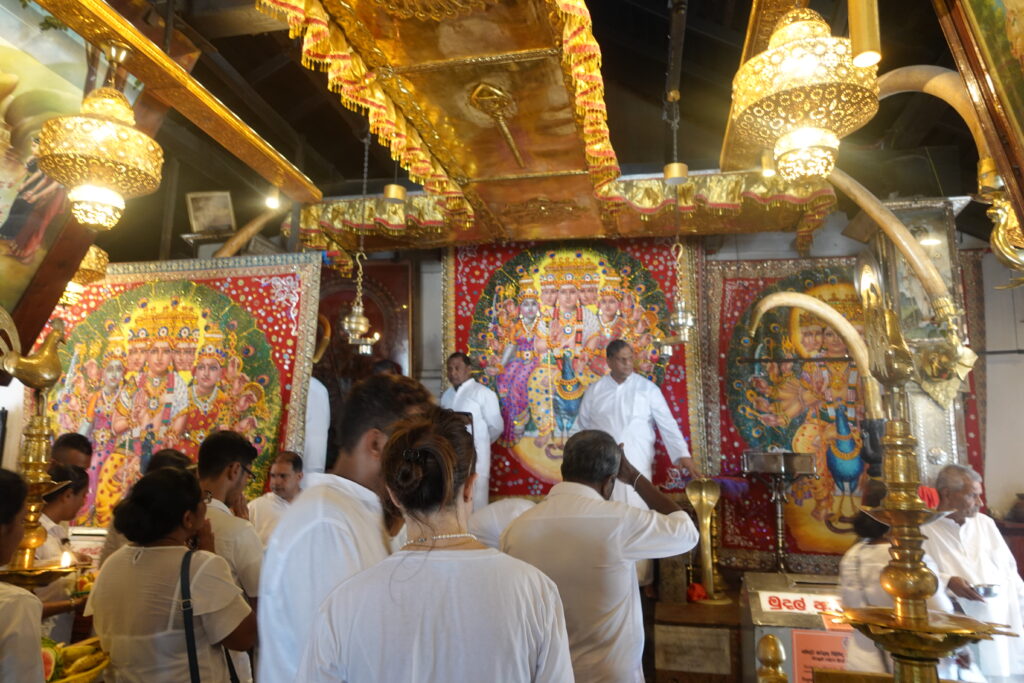
The deity Katharagama itself was originally a Hindu deity, but in Sri Lankan Buddhism, he came to be worshipped as the patron deity of Buddhism. This is quite similar to the Japanese term "kamibutsu shugyo," which means a combination of Buddhism and Shintoism. Thus, Katharagama was an object of faith for both Hindus and Buddhists.
Therefore, coexistence can be seen within the same precinct. Just behind the Kataragama temple stands a magnificent Bodhi tree, where Buddhists can be seen visiting.
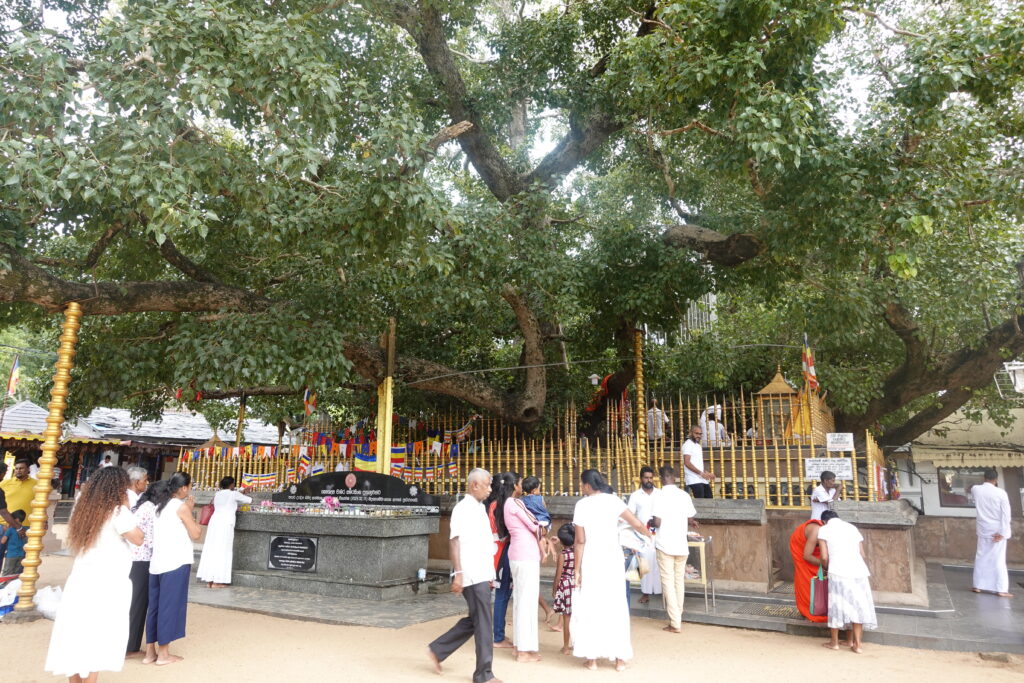
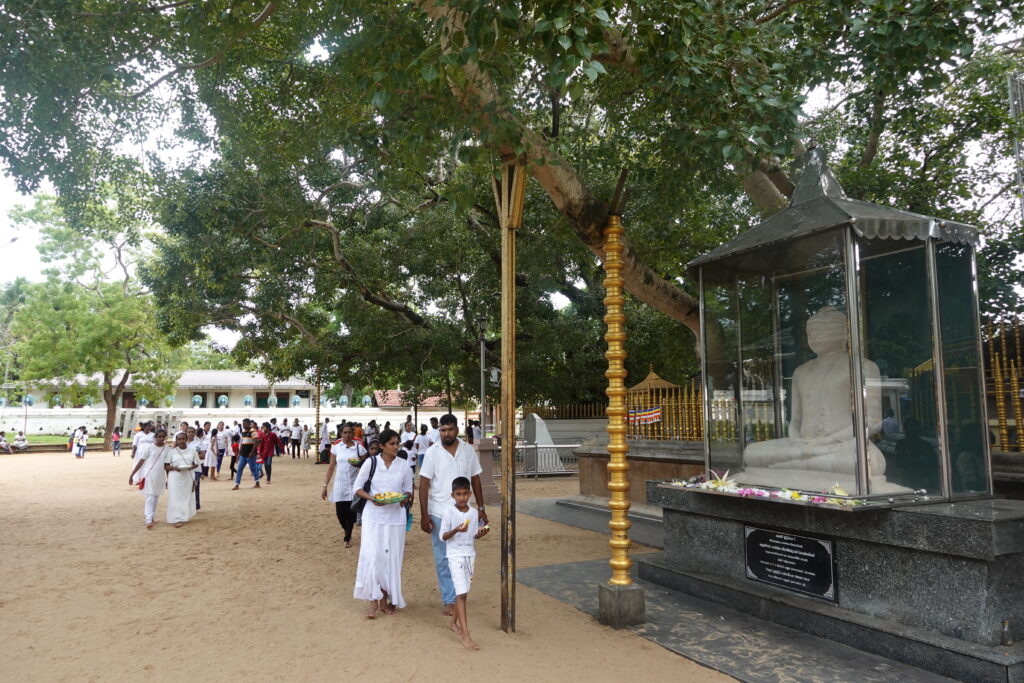
Further on, a gate from the Kataragama Temple to a stupa called Kili Wehera appears.
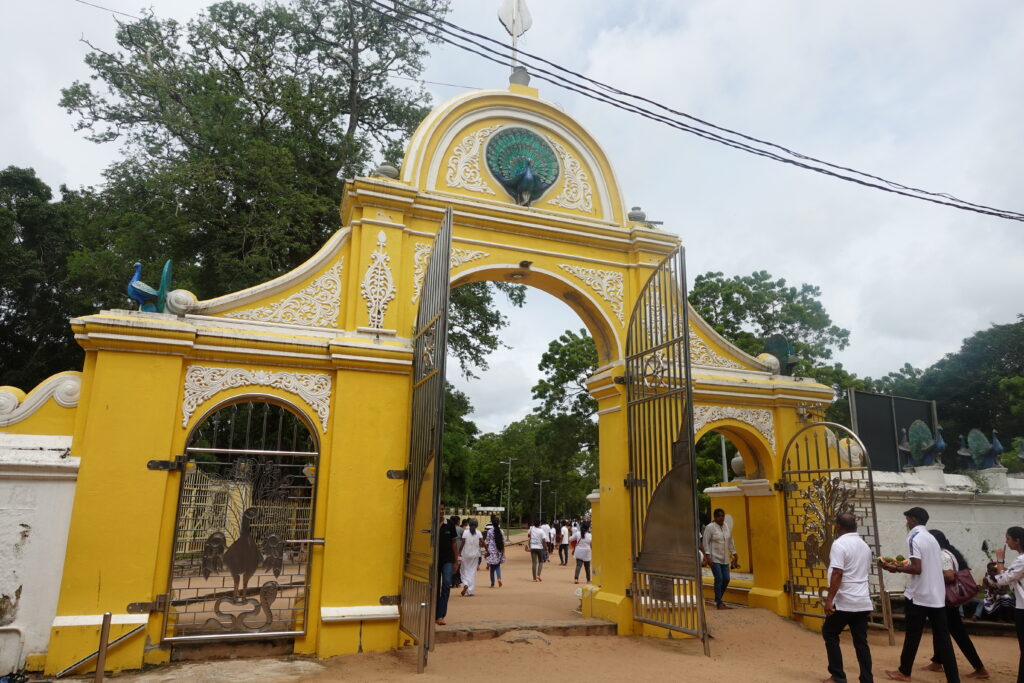
Although Kataragama has a strong Hindu atmosphere, from this point on, the Buddhist color rapidly becomes stronger.
Let us first look at the commentary on this kataragama and Buddhism.
Kataragama cannot be studied in isolation from the Buddhist elements of this complex of sacred sites. Pilgrims customarily worship the deity Kataragama, offer fruits, and then make their way to the Kili Wehera (stupa). To reach the Kili Wehera, pilgrims must pass through the back gate of the Kataragama shrine compound via the path connecting the shrine and the stupa. And as soon as passing through the back gate, pilgrims will encounter beggars and poor people lining the roadside to Kili Wehera. Here are the lame, the wobbly, the swollen, the sick, and the dying old.
The contrast in ethos with the company of Kataragama seen here is dramatic. The pilgrim is confronted with another aspect of secular life: suffering and impermanence. Further on, the pilgrim comes to a store that sells almost nothing but white and red lotus flowers, symbols of Buddhist purity. Then they come to the impressive white stupa of Kiri Wehera.
There, pilgrims chant chants in Pali that praise the Buddha and remind them of the impermanence of all material things (which are likened to withering flowers of fleeting fragrance). Here is an atmosphere quite different from that of the shrine of God Kataragama: peace, repose, and tranquility. The hustle and bustle of the shrine is not heard here, not even the deafening sound of the speakers, which the Sinhalese call the very "iron ro".
If the prominent color at Kataragama is red, the color at Kili Wehera is white. If Kataragama represents a place where sensuality is celebrated, Kili Wehera is a place where sensuality is quenched and transcended. Underlying everything at Kili Wehera is a powerful "mythological model" of the Buddha himself as a world-abandoning being. That is, there is a mythological model in which the Buddha first enjoys the pleasures of life, then encounters the four signs of illness, old age, death, and the yellow-robed mendicant who serves as a model for transcending illness, old age, and death, and finally attains nirvana, the state of tranquility.
And the pilgrim follows the same path as the Buddha. First, by crossing the river, he abandons the daily realities of his worldly existence; then he proceeds to the passion and sensuality of Lord Kataragama; then he is shocked by the suffering and misery of life; and finally, freed from the passion and misery that represent all aspects of impermanence, he realizes the peace and rest that Kiri Wehela possesses.
Some line breaks have been made to make it easier to read on smartphones, etc.
Hozokan, Richard Gombrich, Gananath Obeysekara, translated by Shima Iwa, Buddhism in Sri Lanka, p.251-252
Please keep this commentary in mind. I read it before I went to Sri Lanka and was amazed at how amazing the place was. That is why I came all the way to Kataragama.
Let us now proceed toward Kili Wehara.
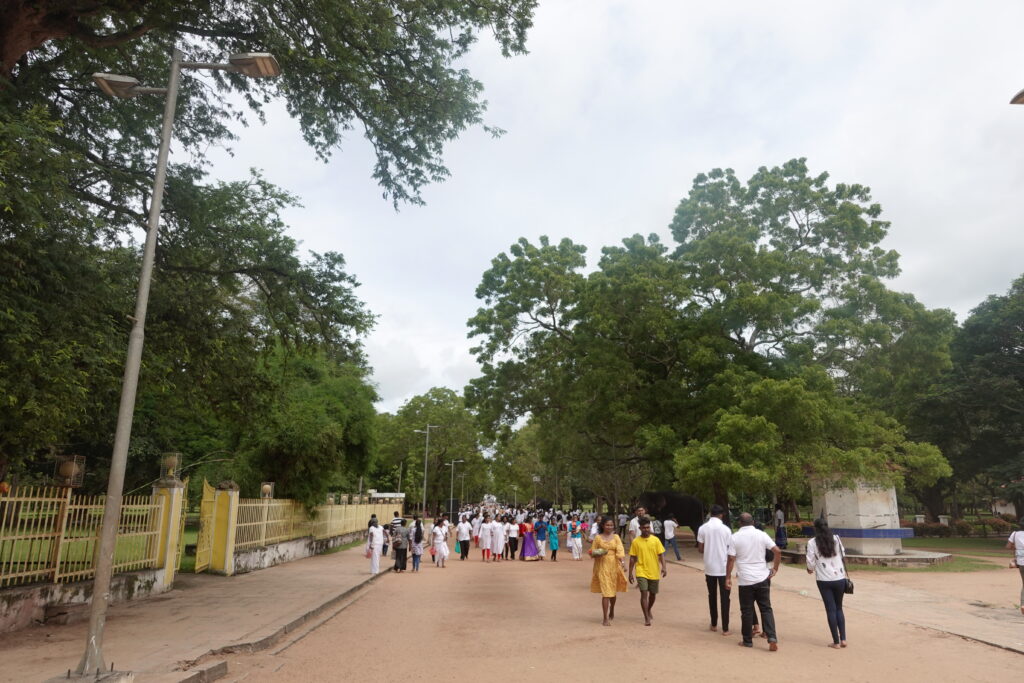
This is the place just outside the gate. According to the commentary above, there are beggars, cripples, wobbly people, people covered in boils, sick people, and old people who are dying here, but I don't see any.
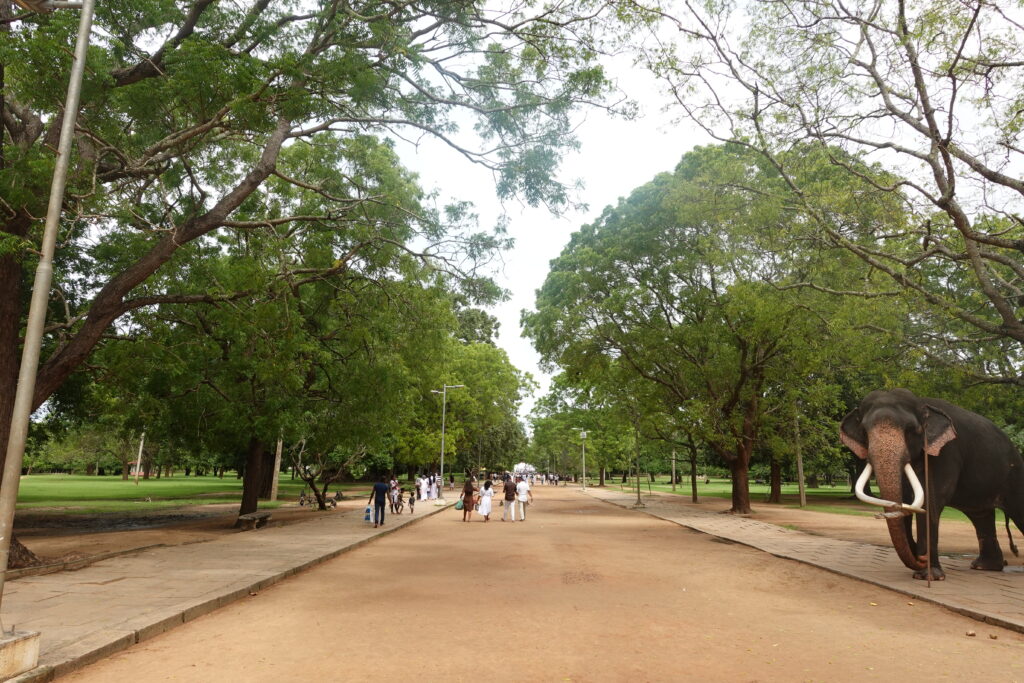
We continued on, but there were no such people to be seen. There were only elephants for show.
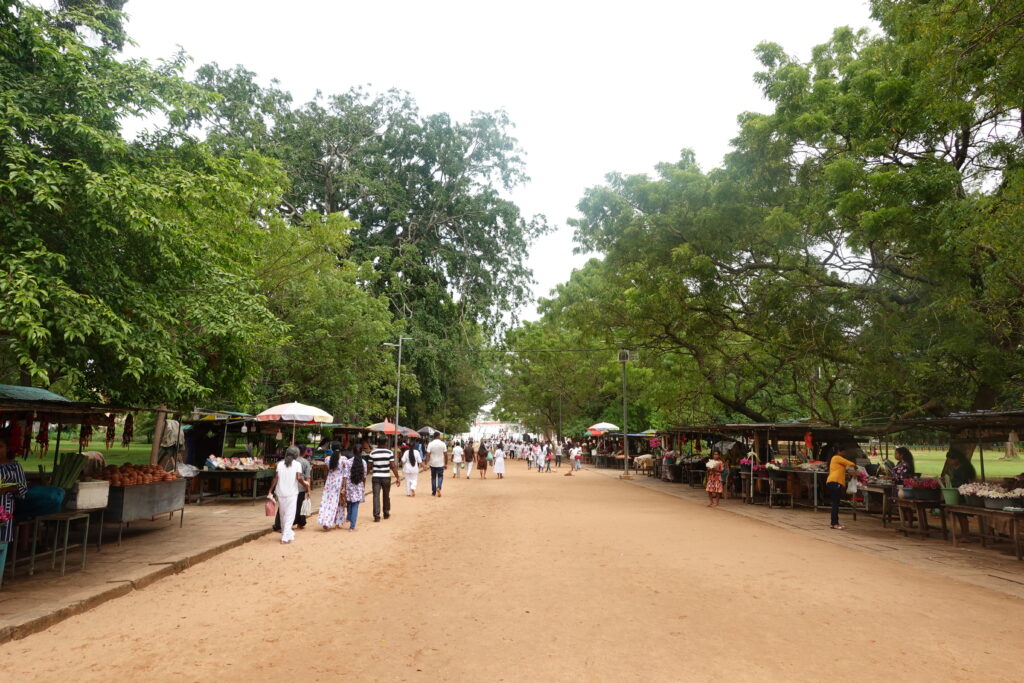
After a short walk, stores began to appear. According to the explanation, the store "sells almost nothing except white and red lotus flowers, symbols of purity in Buddhism," but there were many brightly colored offerings for sale, similar to those at the entrance to Kataragama. The vendors were touting cheerfully.
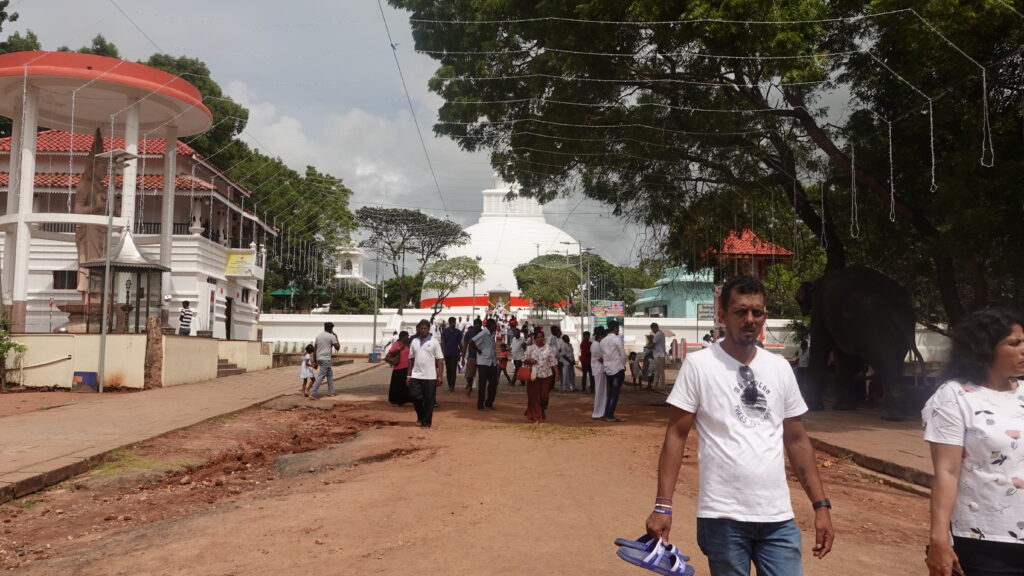
Finally, we came to the vicinity of Kili Wehara. When we reached this area, the atmosphere suddenly became lively. We also noticed that the speakers were broadcasting loudly. This also differs from the commentary.
Right. There is quite a gap between the Kili Wehara area as preached in the commentary above and today. But that cannot be helped. After all, "Buddhism in Sri Lanka," from which the above quotation is taken, was published in 1988, 35 years ago. It was published in 1988, 35 years ago. The atmosphere in Sri Lanka must have changed after such a long time.
And I was curious too, so I asked my guide.
He then told us that in recent years, begging and other activities have been banned throughout Sri Lanka. The government has started to protect them. The Sinhalese, who 35 years ago disliked the Hindu iron mouth, may now be more comfortable with it.
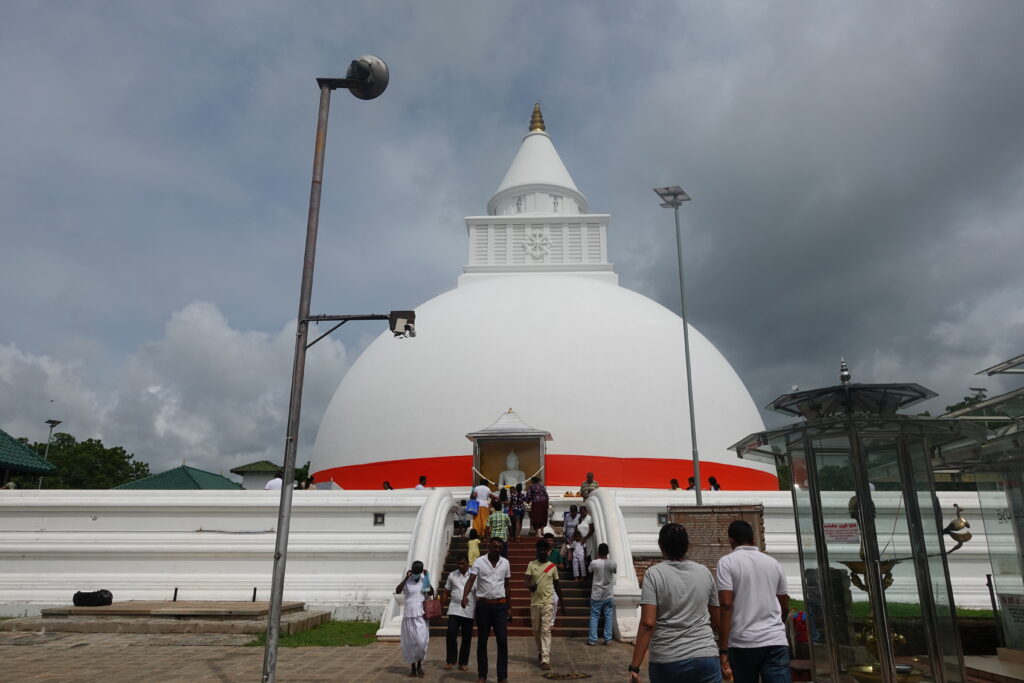
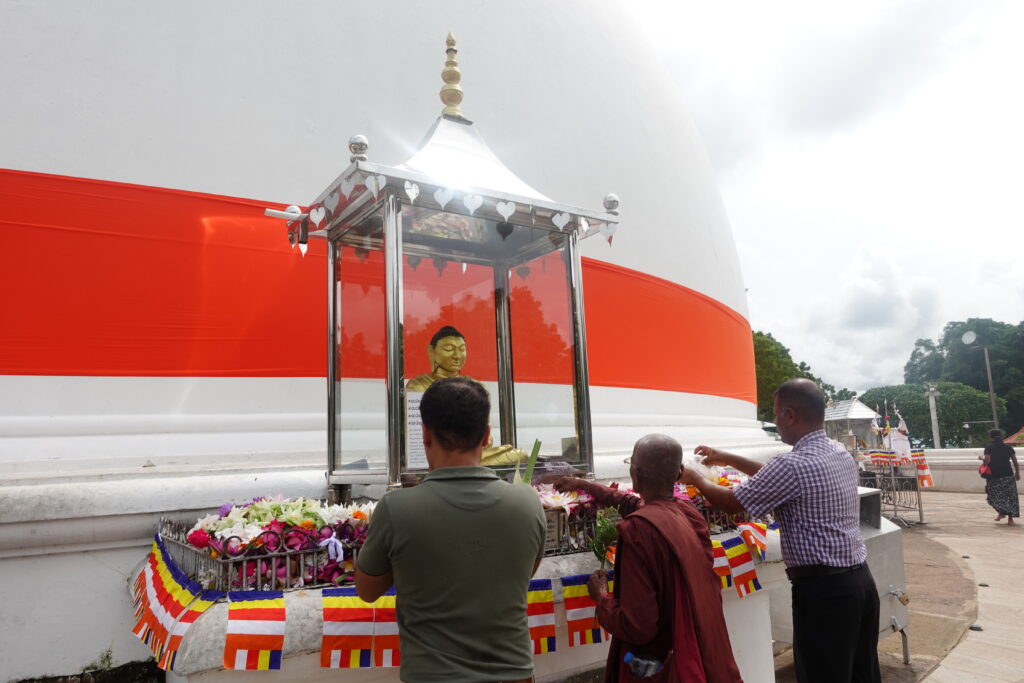
There were several small Buddhist temples set up around Kili Wehara, and we offered flowers and paid our respects.
And this white, beautifully painted Kili Wehara, but looking down, we could see a little brick portion.
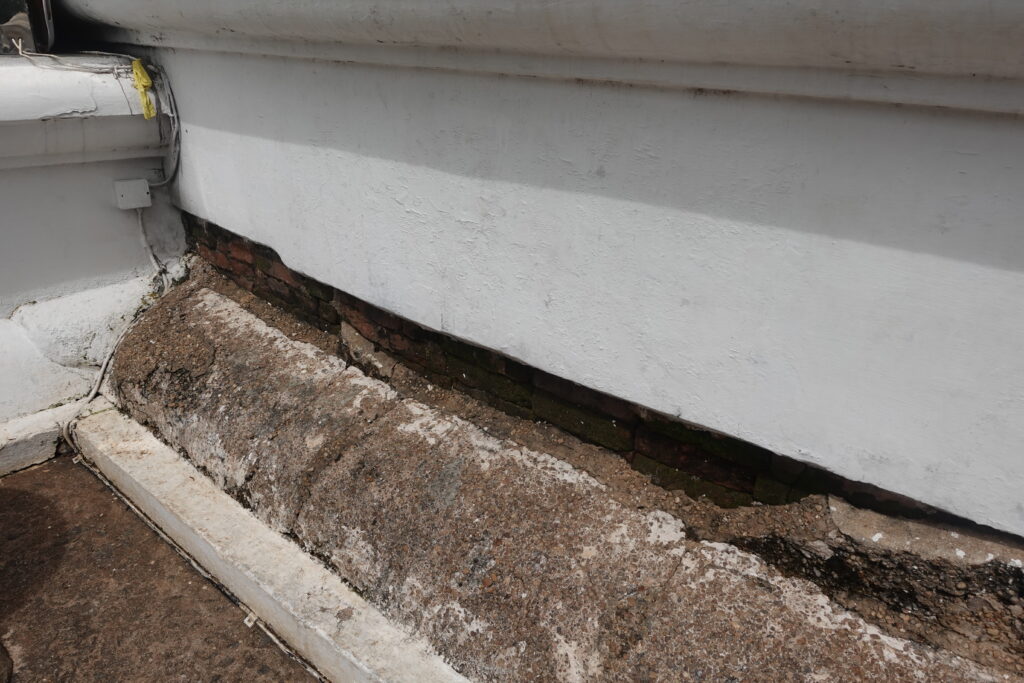
This Kili Wehara has also been recently restored and nicely repainted.(34) Background of Sri Lanka's Civil War and Rapid Revival of Buddhist Sacred Sites: The Relationship between Sinhala Buddhist Nationalism and Sacred Sites."As I mentioned in the article "The Buddhist Sacred Sites in Sri Lanka are closely related to the Sinhala Only policy. This Kili Wehara is a perfect example of this trend.
Of course, Kili Wehara itself has a long history. According to tradition, there is a wide range of theories as to its age, such as the 2nd century B.C. or the late 3rd century A.D., but it is believed that the stupa was built at least in the 4th century A.D. Sri Lankan chronicles tell us that from that time onward, Katharagama was regarded as one of the sacred sites of Buddhism.
But it is also true that its history has had its ups and downs, and there was a long period when it almost lost its presence. Moreover, there was a time when not only Kili Wehara, but also Kataragama as a whole, was on the verge of collapse.
According to an old man whom Obasekara met in Kataragama, Kataragama was in ruins, the temples were crumbling and falling apart, and by 1920 there were almost no pilgrims left, only a few Hindu devotees and mendicants called Sannyasins from Tamil northern Sri Lanka and South India. The number of pilgrims was almost nonexistent until around 1920.
The holy city of Cataragama entered a period of marked decline for almost a hundred years, with a sharp drop in the number of pilgrims. Records from the 1870s show that there were sometimes less than a hundred pilgrims a year. However, from the mid-19th century onward, the pilgrimage gradually began to revive, partly due to the Indian Tamils who were engaged in plantation labor by the British and settled mainly in the central part of the country, who preached the Murugan faith with great zeal. Its content, however, seems to have differed greatly from that of earlier times.
By the early 20th century, the number of pilgrims increased considerably, and by the early 1930s, the number recovered from 10,000 to 25,000 per year. Many of them were believed to have been Hindu, mainly Tamil, and this was partly due to the rise of Sri Lankan Tamil nationalism and the Dravidian revival movement in South India.
As the political and economic situation became unstable in the 1940s, pilgrimages increased. In 1949, Kataragama was connected to the main road, and in 1952, a bus service was opened, and pilgrimages increased. In 1973, the official number of pilgrims was 800,000, and today, about 1 million pilgrims visit the site each year. The content of the pilgrimages has also changed since 1958, and today Sinhalese make up the majority of them. It is clear that this rapid change in the character of the sacred site has been accompanied by social changes.
Some line breaks have been made to make it easier to read on smartphones, etc.
Shunju-sha, Masataka SuzukiReligion and Society in Sri Lanka: A Cultural Anthropological Study.P676-677
It was the increase in the number of Tamil (Sri Lankan Hindu) pilgrims that began the recovery of Katharagama, which had fallen into tatters and disrepair with no pilgrims. Still, as explained above, it was not quite the thriving place it is today.
However, the opening of the road in 1949 and the bus service in 1952 dramatically improved access from Colombo and Kandy. Moreover, those were the days of Sinhalese nationalism. For more information on this Sinhalese nationalism, see(33) Dharmapala and Sinhala Buddhist nationalism: the major currents of modern Sri Lankan Buddhism."As I mentioned in the article "The Revival of Kataragama," the revival of Kataragama had a great deal to do with this political movement.
Thus, in the holy city of Kataragama, Tamil Hindus and Sinhalese Buddhists coexisted and were organically integrated with complementary characteristics, although there were changes over almost four periods. No, there was no such term as Hindu or Buddhist. It is the history of post-colonial Sri Lanka that has created this term as a sign of difference.
As ethnic conflicts gradually intensified during the post-independence Sinhalese favoritism policy, the character of the Kataragama pilgrimage changed dramatically, and today, coupled with the development of mass media and transportation networks, Lord Kataragama has become the national deity of the Sinhalese people and is fully encompassed in their Buddhist worldview.
Buddhist monks claim that Kataragama has been a sacred Buddhist site since ancient times, and they are rapidly turning the sacred site into Buddhism by reinterpreting the past by drawing on Buddhism, using archaeological sites as evidence and the heroic legend of Duttagamani's former erection of the stupa as the basis for their reinterpretation.
The following are some of the many reasons for the establishment of the Perahera: the magnificent covering of the stupa; the creation of a pilgrimage route to reach the stupa directly without going through the temple; the recitation of the Pirit of the Buddhist scriptures prior to the fire-walking; the five-color Buddhist flag (established around 1892 by Colonel Allcott and Madame Blavatsky of the Theosophical Society) at the head of the Perahera, and a Buddhist group walking ahead of the Hindus as the lead of the Perahera. A Buddhist group preceded the Hindus as the lead group of the Perahera, a Buddhist temple called Apinawaramaya was built in front of the sacred castle where the main shrine is located, and a plan to develop the site into a sacred park was made in the 1960s with government assistance, and the Tourism Bureau is supporting this plan.
After 1983, as the conflict intensified, Tamil Hindus gradually stopped coming on pilgrimages, and by 1986 there were almost no Tamil Hindus left, and Katharagama was being transformed into a sacred site dominated by Buddhists. It can be said that the character and rituals of the holy site of Kataragama underwent a major transformation in conjunction with changes in the political situation.
Some line breaks have been made to make it easier to read on smartphones, etc.
Shunju-sha, Masataka SuzukiReligion and Society in Sri Lanka: A Cultural Anthropological Study.P620-621
I highly recommend "Buddhism in Sri Lanka" by Richard Gombrich and Gananath Obeysekara, also cited above, for a detailed explanation of the process by which Katharagama was converted to Buddhism. There is much more that cannot be written here. Katharagama is a place of such historical and cultural interest that a whole book could be written about it. I will not go any deeper in this article.
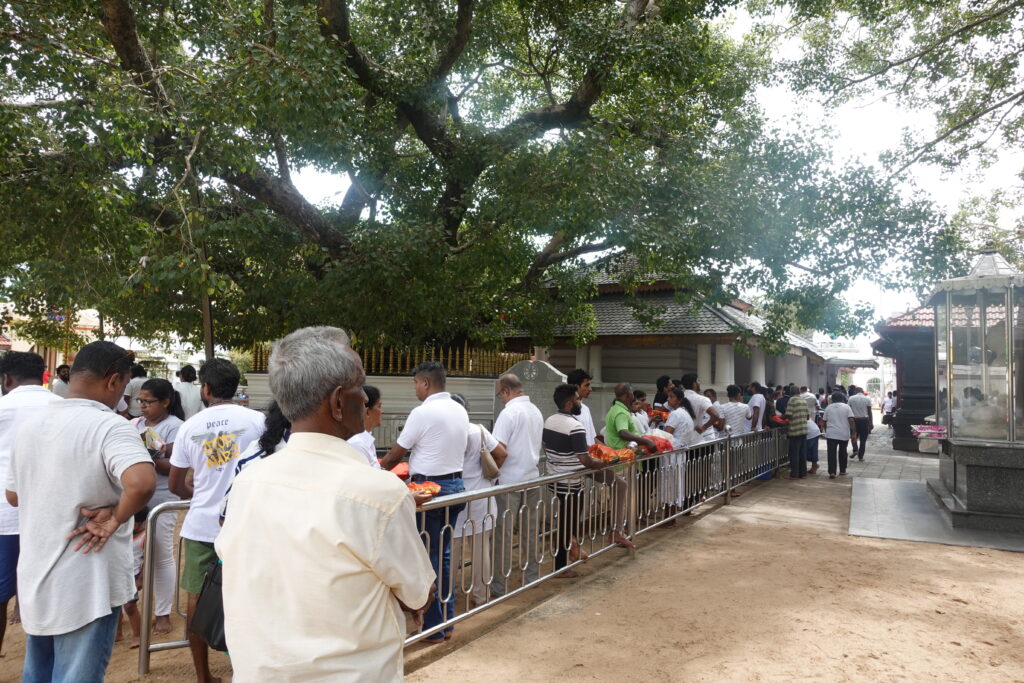
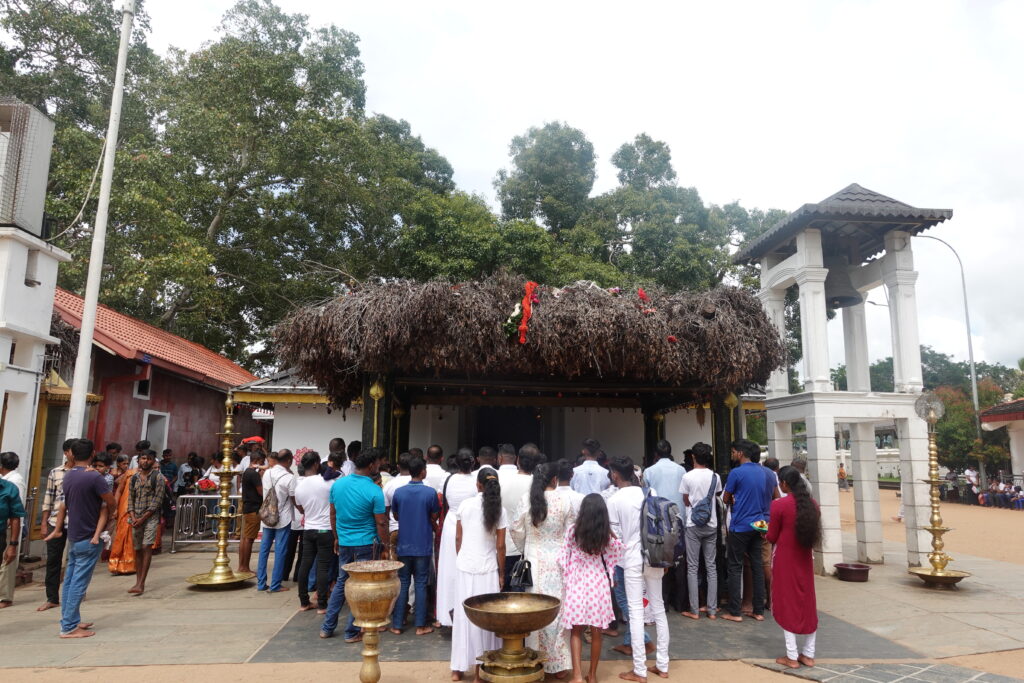
Just as I returned from Kili Wehara, I came across a procession of dedication to the Kataragama Temple. The white clothes are the formal attire of Sinhala Buddhists. You can see from these photos that many people are paying homage to Lord Kataragama in this way.
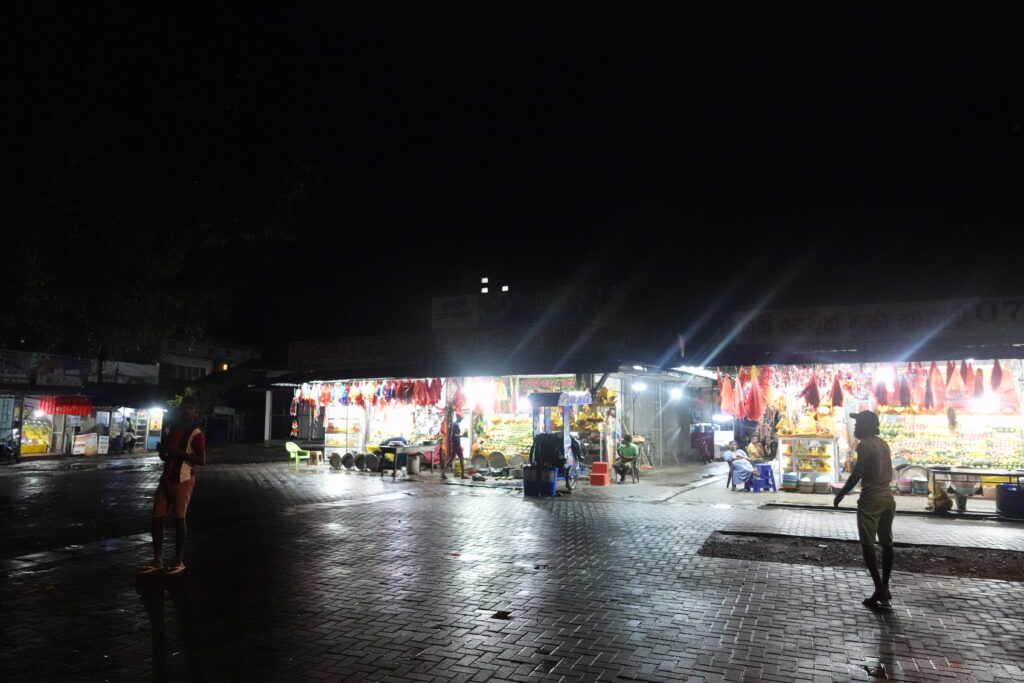
And this evening I came again to the Kataragama Temple. I came to see the night puja.
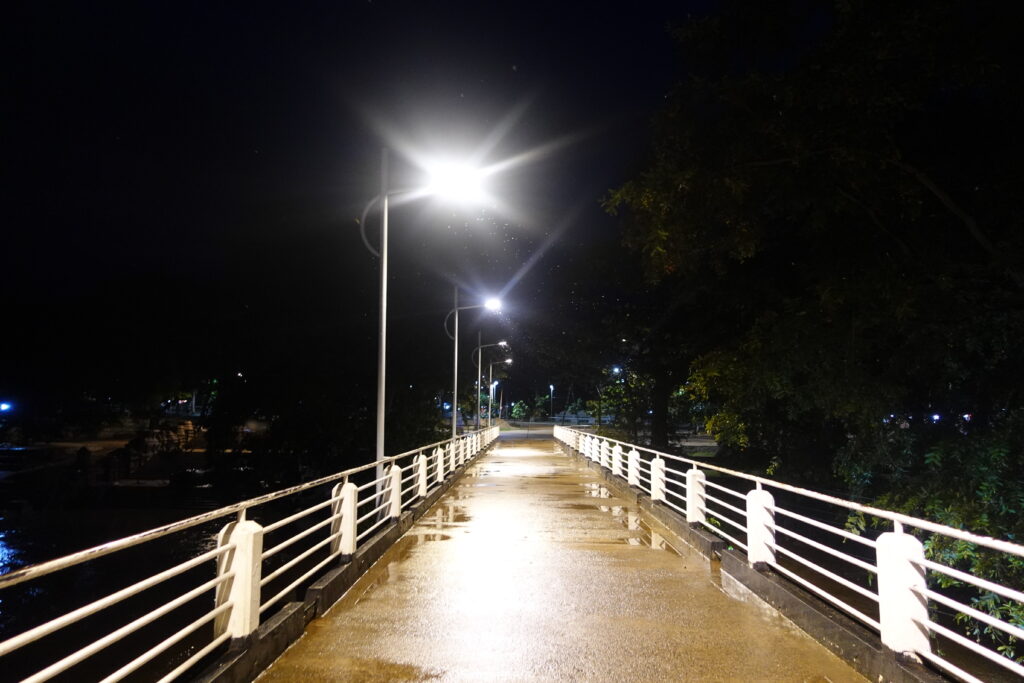
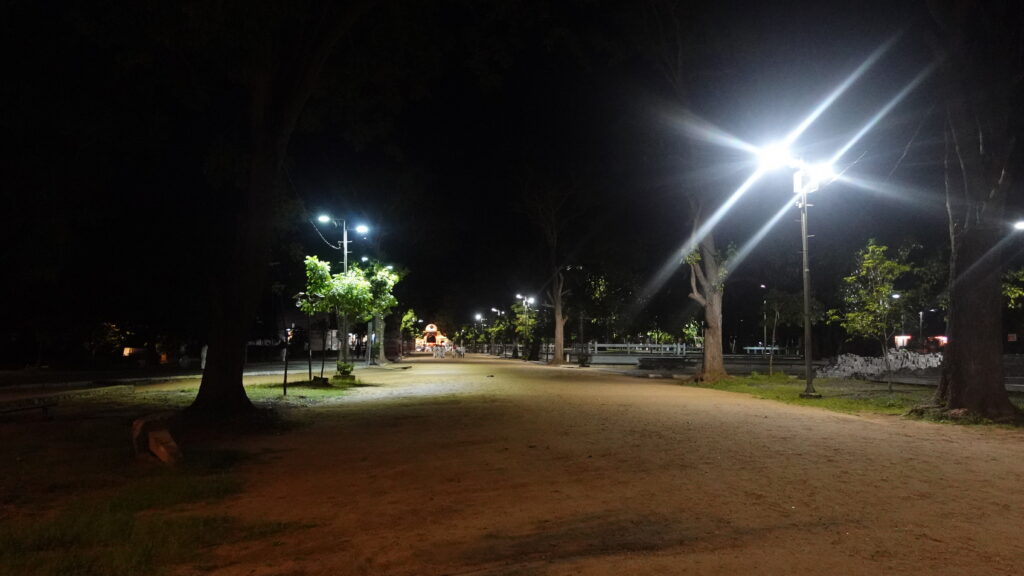
I was surprised that there were fewer people than I had expected. I had an image of the huge crowds in Haridwar, so I felt indescribable in this lonely sanctuary.
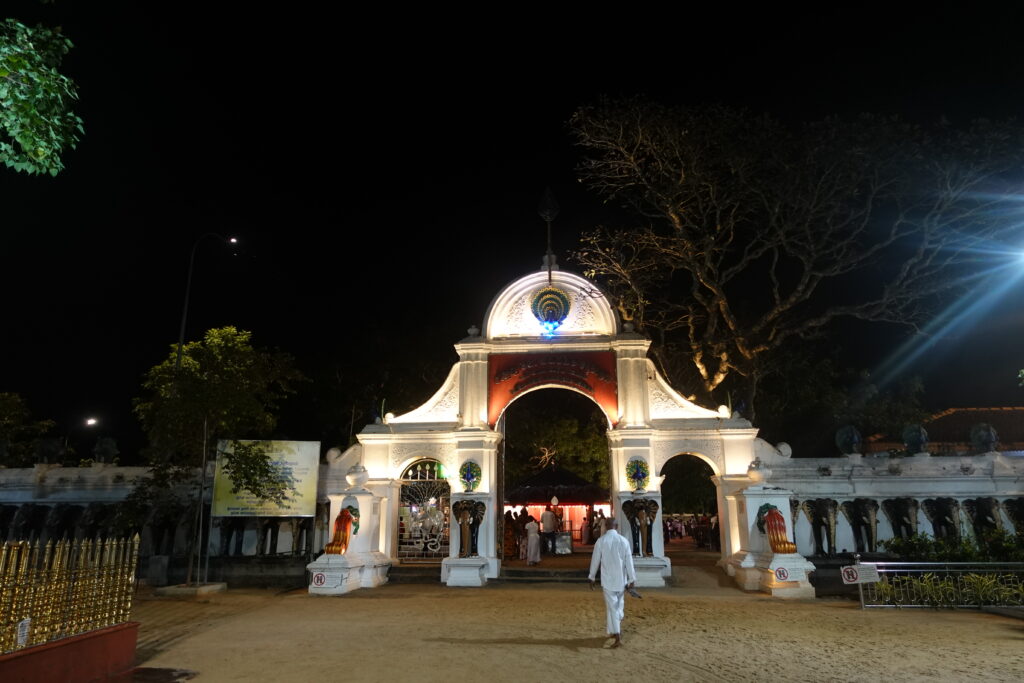
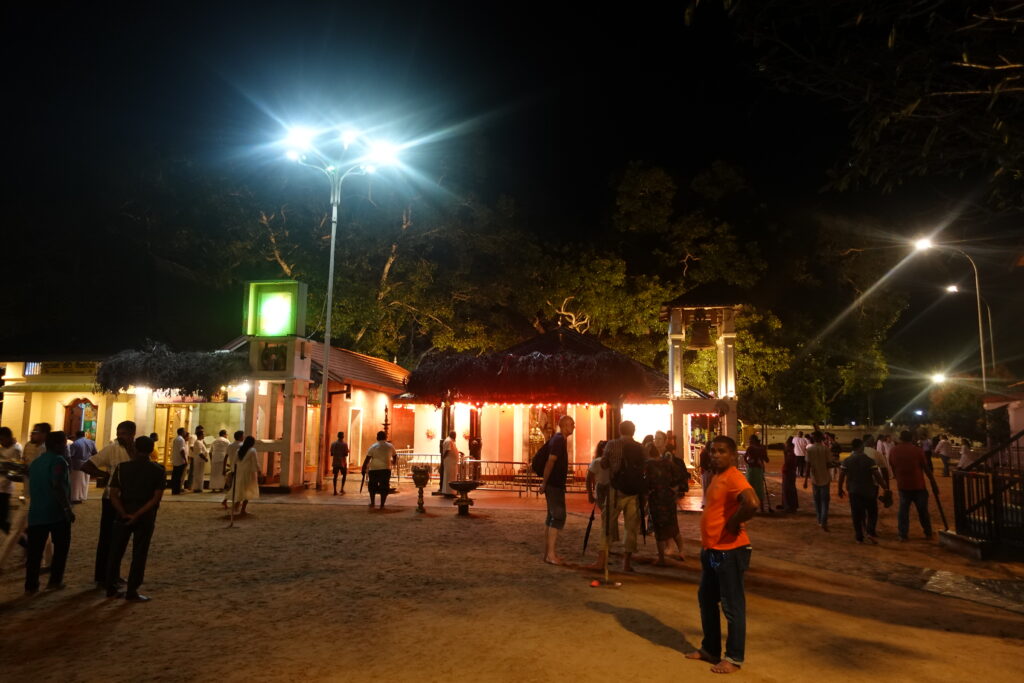
I was relieved to see that there were people in the precincts of the Kataragama Temple. Today it was quite empty, I was told. I heard that during the festival, it is so crowded that it is hard to walk around.
And here I waited for the puja to begin.
The pooja starts around 1 minute into this video.
It is still very small, no matter how many times I see it. Bells, drums, and flutes were sounded and the puja began, but little singing could be heard. I guessed that a prayer ritual was going on inside the temple, but I could hardly see it. A woman who looked like a priestess was lighting a fire. I managed to see a woman who looked like a priestess lighting a fire. This monotonous and motionless puja continued for more than 30 minutes. The pilgrims had no choice but to silently watch the ceremony from outside. Everyone remained motionless.
The guide then said to me, "We're done, let's get going," and I had to leave the place. I honestly did not even know when it was over. Moreover, the drums and flutes continued to be played afterwards. The puja itself was to continue after this, and the pilgrims were going to offer their offerings. I guess it means that the ritual itself is over.
But still, what is this modest, moderate, orderly pooja?
It is a far cry from that entertaining pooja in Haridwar. *(3) Experiencing Haridwar's Prayer Ritual Puja: Pilgrims' enthusiasm and entertaining rituals astonish me."(See article in)
Festivals, extremes, chaos, fervor" - these are the words that come to mind when one thinks of Hindu festivals.
How meek the Sinhalese are in contrast.... However, I sympathize with such Sinhalese. Indians and we Japanese are too different from each other, no matter how you look at it. And, as I thought from the bottom of my heart when I traveled to Sri Lanka, there is a culture and mentality here that is easy for Japanese people to get used to. Order, cleanliness, and modesty" are the top of the list. I also feel that the relationship with the great power of India is similar to the relationship with China in Japan.
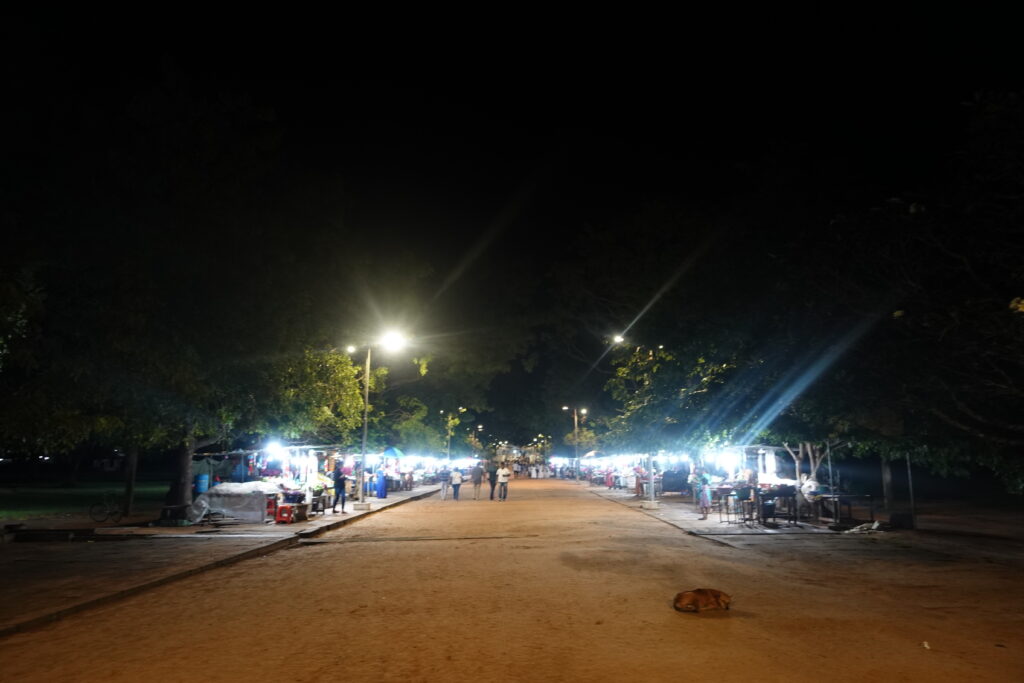
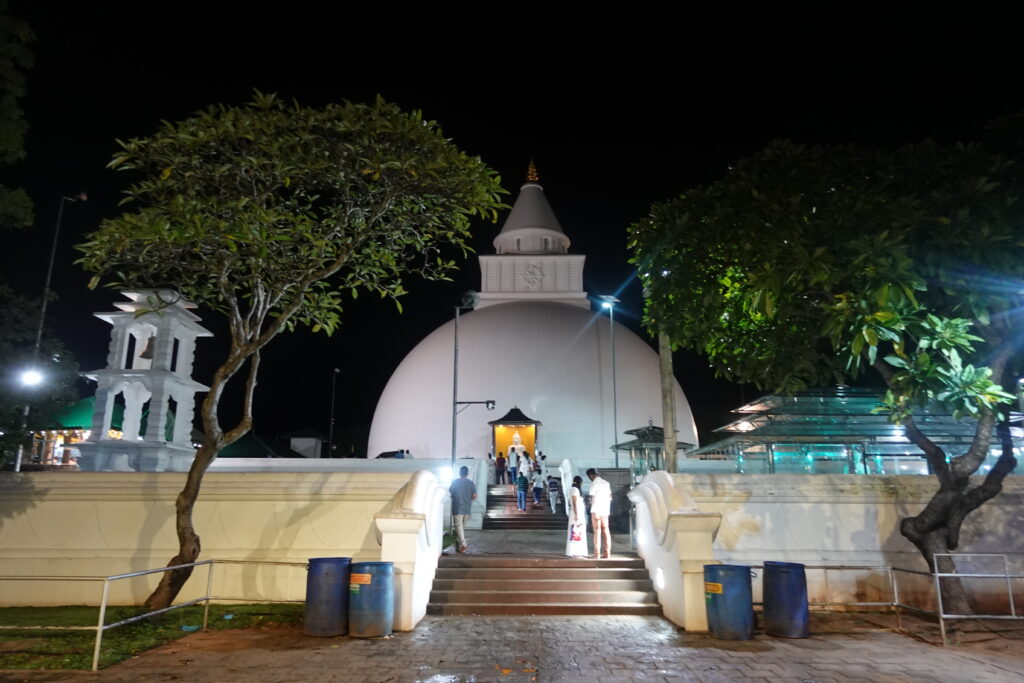
After this I also visited Kili Wehara again.
Only the road leading to Kili Wehara is glimmering in the darkness.
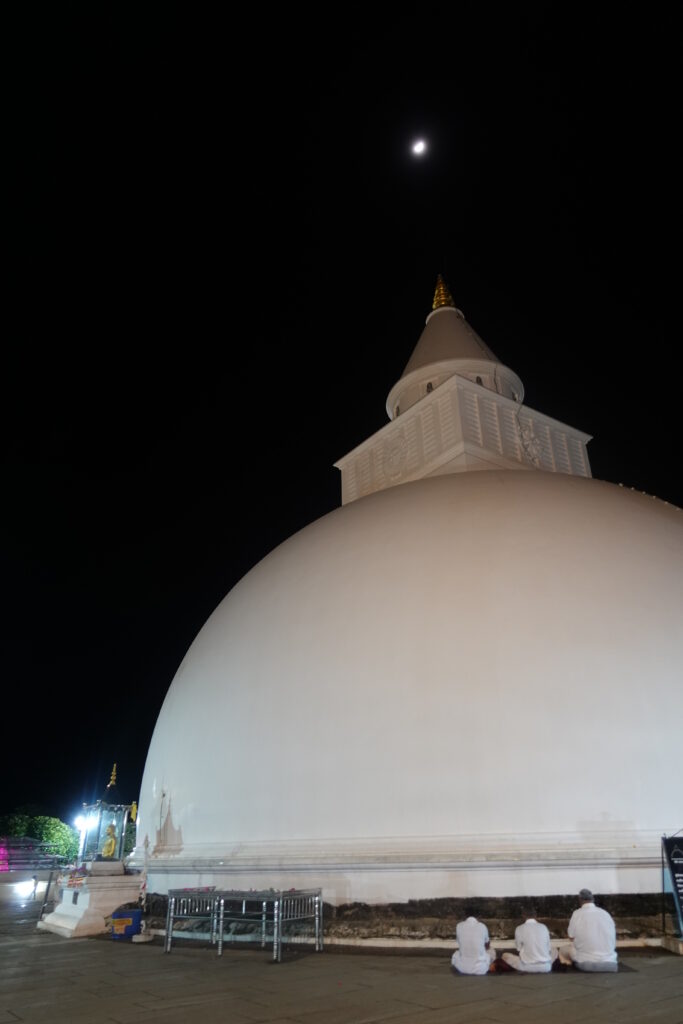
I also paid my respects while watching the moon shining on the chedi. The peaceful air soothed my heart. At night, the heat eases considerably, so it is pleasant just to walk around.
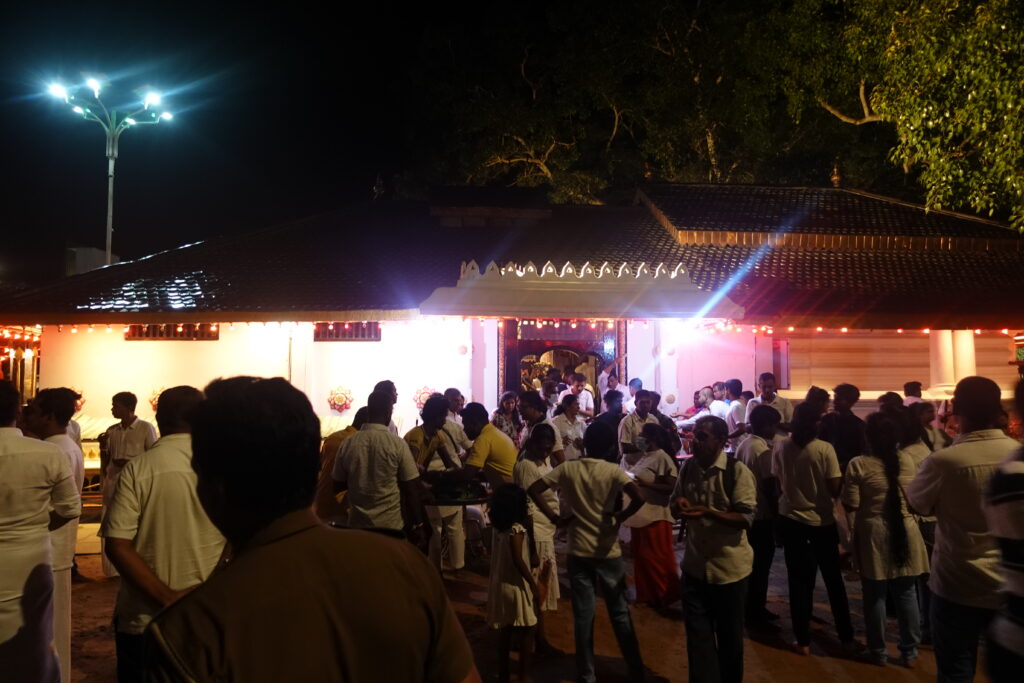
I returned to the Kataragama Temple, but the temple was still crowded with offerings. While I was on my way to Kili Wehara, pilgrims seemed to be arriving one after another.
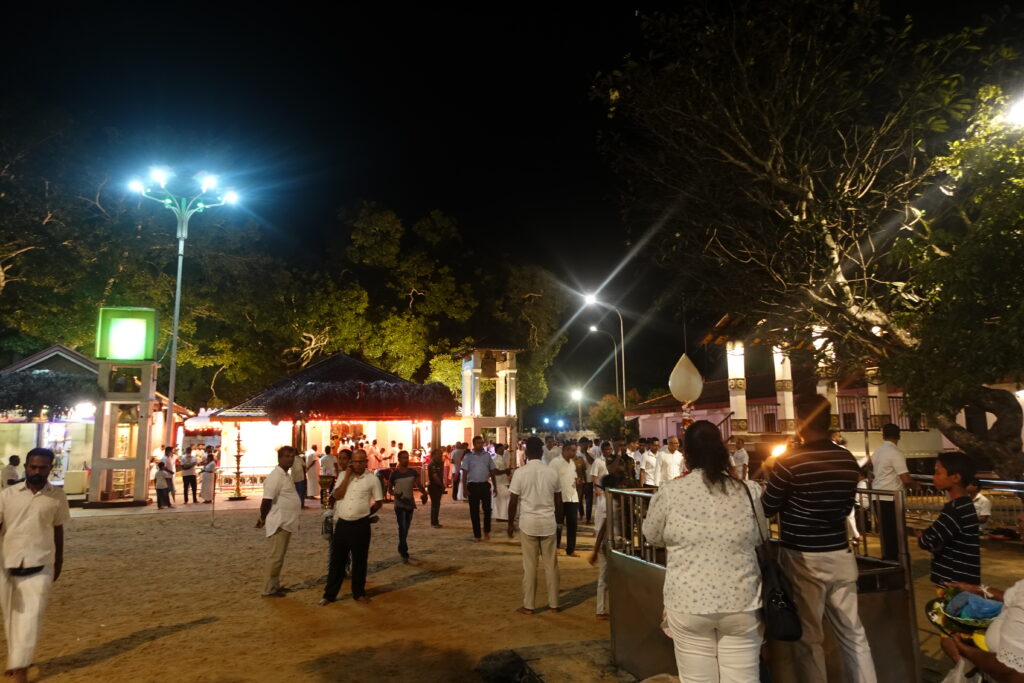
Katharagama cannot be excluded when considering contemporary Sri Lankan religion. The reference book that describes Katharagama in detail is Gombrich and Obersekara's "Katharagama", also cited above.Buddhism in Sri Lanka.and by Masataka SuzukiReligion and Society in Sri Lanka."is recommended. Also, as an introductory book, Toshio Shibuya'sSri Lanka Today Magazine.is another book that is very useful in understanding what kataragama is.
It was a very gratifying experience for me to be able to visit here.
*Below is an article with reference books on India and Sri Lanka that we have referenced in this travelogue. Please refer to them.
periodA list of recommended reference books to help you learn about Indian history, religion, and culture."
periodA list of recommended books for "those who want to know more about Indian Buddhism."
periodA list of recommended books to help you get to know the Buddhist country of Sri Lanka."
Click here to read the previous article.
Related Articles












